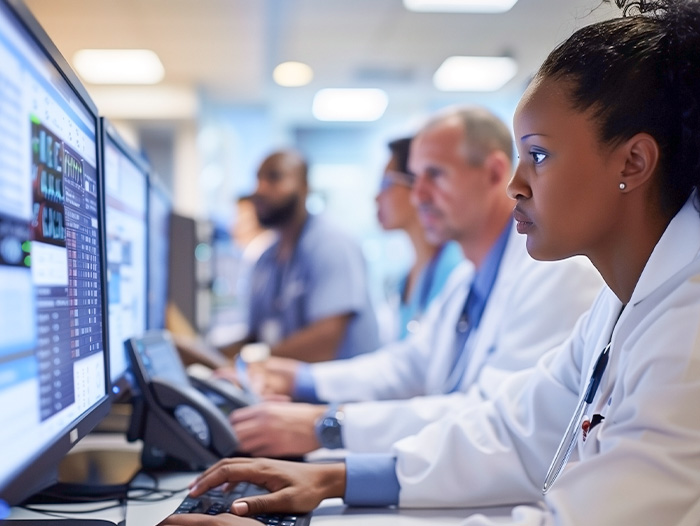ECRI on Wednesday released its 17th annual list of the "Top 10 Health Technology Hazards," identifying medical device use among home users as the top technology threat healthcare organizations face.
Methodology
For the list, ECRI focused on "generic hazards," or the problems that can arise from the risks inherent in the use of certain medical technologies. The list does not discuss the risks tied to specific models or suppliers.
To select the topics, ECRI engineers, scientists, clinicians, and other patient safety analysts nominated topics for consideration based on their own knowledge and expertise gained through:
- Investigating incidents
- Testing medical devices in the ECRI lab
- Observing operations and assessing hospital practices
- Reviewing the literature
- Speaking with clinicians, clinical engineers, technology managers, purchasing staff, health systems administrators, and device suppliers
After the topics were nominated, professionals from various ECRI program areas, as well as external advisors, evaluated the nominations and selected their top 10. Then, ECRI used their feedback to create the final list, while weighing factors including the hazards' breadth, severity, frequency, insidiousness, preventability, and potential for publicity. Although any of the criteria could warrant a nomination to the list, all of ECRI's selected topics must be preventable to some degree.
The 'Top 10 Health Technology Hazards for 2024'
1. Medical device use among home health patients. As more patients receive healthcare in their homes, more medical devices are also being used at home, including devices originally intended for use in a clinical environment. According to ECRI, some of these devices aren't designed to be operated by home users, and the home setting can introduce some environmental limitations that impact device operation. If users don't fully understand how to operate a device, severe harm can result.
2. Inadequate or onerous device cleaning instructions. Not properly cleaning, disinfecting, or sterilizing reusable medical equipment can cause infections to spread, devices to be damaged, and other forms of harm. According to ECRI, many reusable medical devices have incomplete, impractical, or onerous cleaning instructions, making it difficult for healthcare workers to complete these tasks effectively.
3. Sterile drug compounding without technological safeguards. Any errors made while compounding injectable medications can have severe consequences if those errors aren't detected before the drug is administered. Any errors that aren't caught before the preparation leaves the pharmacy have a high likelihood of reaching the patient. Technological safeguards, like workflow management systems, can minimize the opportunities for human error.
4. Overlooking the environmental impacts of patient care. The manufacture, use, and disposal of medical devices, systems, and supplies consume energy, release contaminants, and generate waste, all of which adversely impact the environment. This impact can in turn create public health challenges and exacerbate health inequities.
5. Insufficient governance of AI used in medical technologies. While artificial intelligence (AI) offers many benefits in assisting clinical decisions, shortcomings in AI can also lead to inappropriate responses. Care providers have little insight into the methodology an application uses to reach decisions or the data on which it was trained, which can make it difficult for them to judge a system's performance for their patient population.
6. Ransomware targeting the healthcare sector. Healthcare providers are still being targeted by hackers looking to extract a ransom payment by infiltrating IT networks. During these attacks, hackers can encrypt patient data, extract sensitive information, disable user access, or otherwise compromise a healthcare system's operation, which can disrupt the delivery of patient care.
7. Increased burn risk from single-foil electrosurgical return electrodes. When single-foil conductive return electrodes are used during electrosurgery rather than safer options, like dual-foil conductive return electrodes, patients are placed at an unnecessary risk of burns.
8. Infusion pump damage. Any damage to an infusion pump can affect how accurately it delivers fluids or medications, which can lead to medication administration errors. Damage can also distract staff while they search for a replacement device and could delay therapy for a patient. In addition, if damage is unnoticed or not corrected, multiple patients could end up at risk.
9. Poor quality control of implantable orthopedic products. Implantable orthopedic products can include bone screws, rods, plates, or knee and hip prostheses. Any defects in these products can lead to a delay in surgery or prolonged surgery as well as other harm, including persistent pain or infection.
10. Third-party web analytics software. While third-party web analytics software can provide businesses with useful insights into how customers use their website, the tools can also allow third-party companies like Meta, Google, or Adobe to collect information that could reveal details about a patient's medical condition. That information, like the patient's IP address, appointment scheduling details, or other data, could then be used for inappropriate purposes, like tracking a patients' online activity to target them with ads related to their medical condition.
How providers can help home health patients
Marcus Schabacker, president and CEO of ECRI, noted there are a variety of life-threatening risks associated with using complicated medical equipment at home, including medication errors from infusion pumps and skin injuries from cardiac monitors.
While clinics use standard practices and evidence-based processes, those don't apply in the home, Schabacker said, meaning providers need to think about how they can help patients understand their equipment.
"How do we advise patients to use the device safely?" he said. "How do we make them easier to operate and understand? And what kind of framework do we have so that if there is a technical or a medical problem, it can be addressed quickly and effectively?"
Schabacker recommends having an infrastructure in place for troubleshooting, such as a 24-hour call center.
He added that, while home care can provide many advantages for patients, the healthcare sector has a ways to go before it reaches zero preventable harm.
"We want to make sure that the efforts we spent decades on in the hospital, to have quality assurance processes, are now getting transferred into the home," Schabacker said. (ECRI's Top 10 Health Technology Hazards for 2024 list, 1/31; Devereaux, Modern Healthcare, 2/1)
Advisory Board is kicking off research to better understand what role technology should (or shouldn't) play in supporting clinical staff. Here are three key things about clinical workforce technology that we've found so far.
Don't miss out on the latest Advisory Board insights
Create your free account to access 1 resource, including the latest research and webinars.
Want access without creating an account?
You have 1 free members-only resource remaining this month.
1 free members-only resources remaining
1 free members-only resources remaining
You've reached your limit of free insights
Become a member to access all of Advisory Board's resources, events, and experts
Never miss out on the latest innovative health care content tailored to you.
Benefits include:
You've reached your limit of free insights
Become a member to access all of Advisory Board's resources, events, and experts
Never miss out on the latest innovative health care content tailored to you.
Benefits include:
This content is available through your Curated Research partnership with Advisory Board. Click on ‘view this resource’ to read the full piece
Email ask@advisory.com to learn more
Click on ‘Become a Member’ to learn about the benefits of a Full-Access partnership with Advisory Board
Never miss out on the latest innovative health care content tailored to you.
Benefits Include:
This is for members only. Learn more.
Click on ‘Become a Member’ to learn about the benefits of a Full-Access partnership with Advisory Board
Never miss out on the latest innovative health care content tailored to you.


